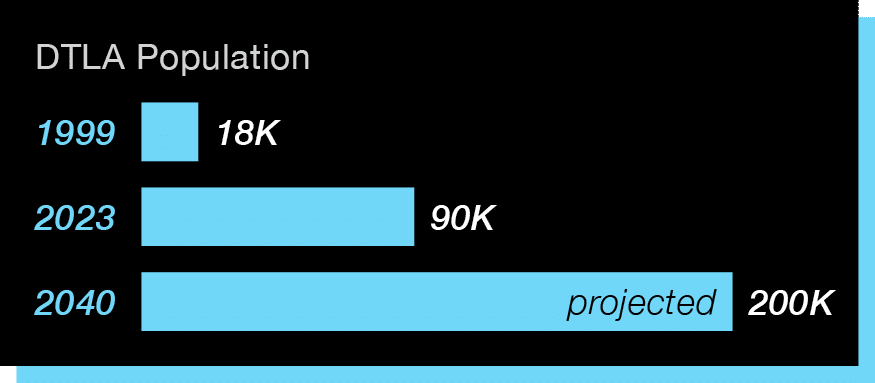Downtown Reimagined
Downtown Los Angeles is at an important inflection point in its trajectory, most immediately due to the catalytic impact of seismic shifts in the nature of office work, but more broadly, and deeply, because of the ways it has grown and changed over the last 20 years, which have laid the foundation for even more dramatic development and progress over the next 20.

Downtown’s residential population quadrupled over the last two decades, from under 18,000 in 1999 to over 90,000 today. During that period over 1,000 new restaurants and retail businesses opened, and the number of visitors to Downtown soared to over 22 million annually. Prior to the pandemic, the working population in DTLA grew steadily as well, and more importantly diversified significantly, with major growth in newer creative and technology industries.
The recently approved DTLA 2040 Community Plan projects the residential population will more than double again over the next two decades to over 200,000. A population of 200,000 would make Downtown the equivalent of an average mid-sized American city unto itself. But because those 200,000 residents are joined by hundreds of thousands of workers and tens of millions of visitors, DTLA is and will remain – unlike your average mid-sized city – a highly influential center of commerce and culture, and a global destination.
So as we reimagine DTLA’s future in light of current changes in the office sector – no matter how significant – it should be in that more holistic context. It should also be noted that the dynamic growth of Downtown’s residential population, hospitality and tourism sector, arts and culture, dining, nightlife and entertainment scenes will continue to enhance its appeal as a place to work or locate an office as well.
With the completion of Metro’s Regional Connector, Downtown is positioned to become an even more essential hub for the Southern California region, but with the kind of local growth and diversification discussed above, it is also on a parallel path to being the quintessential 15-minute city, with everything one needs to live, work, and play in walkable/bikeable proximity.
Regional Connector
As the 2028 Olympics – for which Downtown will be the most prominent location – approaches, this vision of DTLA as both regional center and complete city is coming into focus. Because Downtown is the seat of government for the city and county, with a vital civic sector, and because it also boasts some of the most sophisticated investors and developers in the real estate industry, making that vision a reality is well within our grasp. The DTLA 2040 plan is the blueprint, and adaptive reuse, broadly defined as it is here, is one of the key strategies.
Downtown Los Angeles has an illustrious history of adaptation that will serve it well in its next chapter. Whether converting historic buildings into hip lofts, iconic theaters to flagship retailers, or newspaper headquarters into university campuses, DTLA has evolved with the times and come out ahead of the curve – more dynamic, exciting, and appealing than before. The current changes roiling the office sector will be a catalyst for the next cycle of DTLA’s transformation, driven by the spirit of reinvention that has fueled its growth through multiple eras and will propel it into the future.